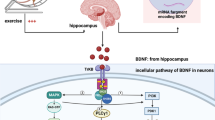Abstract
Objective
To investigate the preventive treatment effects of electroacupuncture (EA) on cognitive changes and brain damage in senescence-accelerated mouse prone 8 (SAMP8) mice.
Methods
The 5-month-old male SAMP8 and age-matched homologous normal aging mice (SAMR1) were adopted in this study. EA stimulation at Baihui (GV 20) and Yintang (EX-HN 3) was performed every other day for 12 weeks, 4 weeks as a course. Morris water maze test and Nissl-stained with cresyl violet were used for cognitive impairments evaluation and brain morphometric analysis. Amyloid-β (A β) expression in hippocampus and parietal cortex was detected by immunohistochemistry, and apoptosis was observed by TUNEL staining.
Results
After 3 courses of EA preventive treatment, the escape latencies of 8-month-old SAMP8 mice in EA group were significantly shortened than those of un-pretreated SAMP8 mice. Compared with SAMR1 mice, extensive neuronal changes were visualized in the CA1 area of hippocampus in SAMP8 mice, while these pathological changes and attenuate cell loss in hippocampal CA1 area of SAMP8 mice markedly reduced after EA preventive treatment. Furthermore, A β expression in hippocampus and parietal cortex of SAMP8 mice decreased significantly after EA treatment, and neuronal apoptosis decreased as well.
Conclusion
EA preventive treatment at GV 20 and EX-HN 3 might improve cognitive deficits and neuropathological changes in SAMP8 mice, which might be, at least in part, due to the effects of reducing brain neuronal damage, decreasing neuronal apoptosis and inhibiting A β-containing aggregates.
Similar content being viewed by others
References
Tanzi RE, Bertram L. Twenty years of the Alzheimer’s disease amyloid hypothesis: a genetic perspective. Cell 2005;120:545–555.
Huang Y, Mucke L. Alzheimer mechanisms and therapeutic strategies. Cell 2012;148:1204–1222.
Su D, Li L. Trends in the use of complementary and alternative medicine in the United States: 2002-2007. J Health Care Poor Underserved 2011;22:296–310.
Kaptchuk TJ. Acupuncture: theory, efficacy, and practice. Ann Intern Med 2002;136:374–383.
Cady RK, Farmer K. Acupuncture in the treatment of headache: a traditional explanation of an ancient art. Headache 2015;55:457–464.
Zhou Y, Jin J. Effect of acupuncture given at the HT 7, ST 36, ST 40 and KI 3 acupoints on various parts of the brains of Alzheimer’s disease patients. Acupunct Electrother Res 2008;33:9–17.
Peng XW, Dong KL. Clinical observation on acupuncture combined with Yizhi Jiannao Granules for treatment of Alzheimer’s disease. Chin Acupunct Moxibust (Chin) 2009;29:269–271.
Zhu H, Dong KL, Wu Y, Zhang T, Li RM, Dai SS, et al. Influence of acupuncture on isoprostane in patients with Alzheimer’s disease. Chin Acupunct Moxibust (Chin) 2010;30:18–21.
Lee GJ, Yin CS, Choi SK, Choi S, Yang JS, Lee H, et al. Acupuncture attenuates extracellular glutamate level in global ischemia model of rat. Neurol Res 2010;32:79–83.
Chen Y, Zhou J, Li J, Yang SB, Mo LQ, Hu JH, et al. Electroacupuncture pretreatment prevents cognitive impairment induced by limb ischemia-reperfusion via inhibition of microglial activation and attenuation of oxidative stress in rats. Brain Res 2012;1432:36–45.
Chen GH, Wang YJ, Wang XM, Zhou JN. Accelerated senescence prone mouse-8 shows early onset of deficits in spatial learning and memory in the radial six-arm water maze. Physiol Behav 2004;82:883–890.
Morley JE. The SAMP8 mouse: a model of Alzheimer disease? Biogerontology 2002;3:57–60.
Gong Y, Liu L, Xie B, Liao Y, Yang E, Sun Z. Ameliorative effects of lotus seedpod proanthocyanidins on cognitive deficits and oxidative damage in senescence-accelerated mice. Behav Brain Res 2008;194:100–107.
Pallas M, Camins A, Smith MA, Perry G, Lee HG, Casadesus G. From aging to Alzheimer’s disease: unveiling "the switch" with the senescence-accelerated mouse model (SAMP8). J Alzheimers Dis 2008;15:615–624.
Butterfield DA, Poon HF. The senescence-accelerated prone mouse (SAMP8): a model of age-related cognitive decline with relevance to alterations of the gene expression and protein abnormalities in Alzheimer’s disease. Exp Gerontol 2005;40:774–783.
Gu W, Jin XX, Zhang YJ, Li ZJ, Kong Y. Clinical observation of Alzheimer’s disease treated with acupuncture. Chin Acupunct Moxibust (Chin) 2014;34: 1156–1160.
Lu J, Li KC. fMRI study of acupuncture mechanism underlying Alzheimer’s. J Med Imaging 2011;21:302–304.
Zeng BY, Salvage S, Jenner P. Effect and mechanism of acupuncture on Alzheimer’s disease. Int Rev Neurobiol 2013;111:181–195.
Hunter AJ, Mackay KB, Rogers DC. To what extent have functional studies of ischaemia in animals been useful in the assessment of potential neuroprotective agents? Trends Pharmacol Sci 1998;19:59–66.
Sheng JG, Zhou XQ, Mrak RE, Griffin WS. Progressive neuronal injury associated with amyloid plaque formation in Alzheimer disease. J Neuropathol Exp Neurol 1998;57:714–717.
Fifre A, Sponne I, Koziel V, Kriem B, Yen Potin FT, Bihain BE, et al. Microtubule-associated protein MAP1A, MAP1B, and MAP2 proteolysis during soluble amyloid beta-peptideinduced neuronal apoptosis. Synergistic involvement of calpain and caspase-3. J Biol Chem 2006;281:229–240.
Hardy JA, Higgins GA. Alzheimer’s disease: the amyloid cascade hypothesis. Science 1992;256:184–185.
Hardy J, Selkoe DJ. The amyloid hypothesis of Alzheimer’s disease: progress and problems on the road to therapeutics. Science 2002;297:353–356.
Zhao L, Shen P, Han Y, Zhang X, Nie K, Cheng H, et al. Effects of acupuncture on glycometabolic enzymes in multiinfarct dementia rats. Neurochem Res 2011;36:693–700.
Wang T, Liu CZ, Yu JC, Jiang W, Han JX. Acupuncture protected cerebral multi-infarction rats from memory impairment by regulating the expression of apoptosis related genes Bcl-2 and Bax in hippocampus. Physiol Behav 2009;96:155–161.
Acknowledgements
The authors acknowledge Prof. CHEN Qing-xuan, Institute of Genetics and Developmental Biology, Chinese Academy of Sciences, for kindly offering the SAMP8 and SAMR1 mice.
Author information
Authors and Affiliations
Corresponding author
Additional information
Supported by the National Natureal Science Foundation of China (No. 30701121)
Rights and permissions
About this article
Cite this article
He, Xl., Zhao, Sh., You, W. et al. Neuroprotective Effects of Electroacupuncture Preventive Treatment in Senescence-Accelerated Mouse Prone 8 Mice. Chin. J. Integr. Med. 24, 133–139 (2018). https://doi.org/10.1007/s11655-016-2265-z
Received:
Published:
Issue Date:
DOI: https://doi.org/10.1007/s11655-016-2265-z




